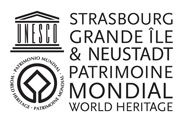- Discover
- Must-see attractions
- As you like it
- Strasbourg, capital of Christmas
- “Strasbourg mon amour”
- UNESCO
- Sustainable Tourism
- The french cycling capital
- Strasbourg and its surrounding area
- Excursions less than 2 hours away
- What to see and do
- Organising my stay
- 1-2-3 Days in Strasbourg
- Places to stay
- Places to eat
- Travelling to and around Strasbourg
- Brochures
- Strasbourg City Card
- Activities and incentives for groups
- Book a guided tour
-
St. Paul’s Church
As one of the most remarkable churches in Strasbourg, the Saint-Paul Church holds such a special place that it is often confused with the cathedral!
Located at the end of Saint-Helene Island on one of the most beautiful spots in the Neustadt district, the church is part of a stunning landscape, sitting beside the banks of the Ill River.
Its location near the imperial quarter and its spectacular urban backdrop underscore the building's political significance, as in former times it was frequently visited by the emperor.
A symbol of German power
The Saint-Paul Church was built between 1892 and 1897, after the city was annexed by Germany, based on the plans of architect Louis Müller. It has two twin 76-metre spires and a large rose window measuring eight metres in diameter.
Constructed in Rhine Neo-Gothic style, it was heavily inspired by the Saint-Elisabeth Church in Marburg, which at the time was viewed as the model for German Gothic architecture. This was not just an aesthetic choice. With the prestigious affiliation to this architectural style, the church stood as a symbol of the legitimacy of German power on the newly (re)conquered Alsatian territories.
Visible from all around the city, the church became the link between the old city and the new one (the Neustadt, built by the Germans). It also established in the imperial quarter a richly symbolic connection between power (represented by the emperor's palace) and knowledge (the university).
A garrison church
Intended as the Protestant garrison, the church could hold more than 3,000 worshippers. Its nineteen doors allowed military leaders and soldiers to enter in an orderly manner according to their respective ranks and quickly exit if needed.
During his time in Strasbourg, the emperor often went to the church. One particular entrance was created next to the western transept. It was originally marked by the sculpted decoration of its tympanum, which displayed the Hohenzollern coat of arms. The stairway that led to the old imperial loggia – today occupied by an organ – has kept its elaborate polychrome décor.
The church kept a part of its original stained glass windows, which show allegories of the empire and the coat of arms of the different regions that comprised it (beneath the rose window).
Like its Catholic counterpart, the Saint-Pierre-le-Jeune Church, this church was designed as a genuine complete work of art. The interior décor (chandeliers, stained glass windows, furniture and liturgical furnishings) contribute to unifying the church's overall style. While the church is only open to the public intermittently, it regularly holds wonderful concerts.
Type of place Religious site









